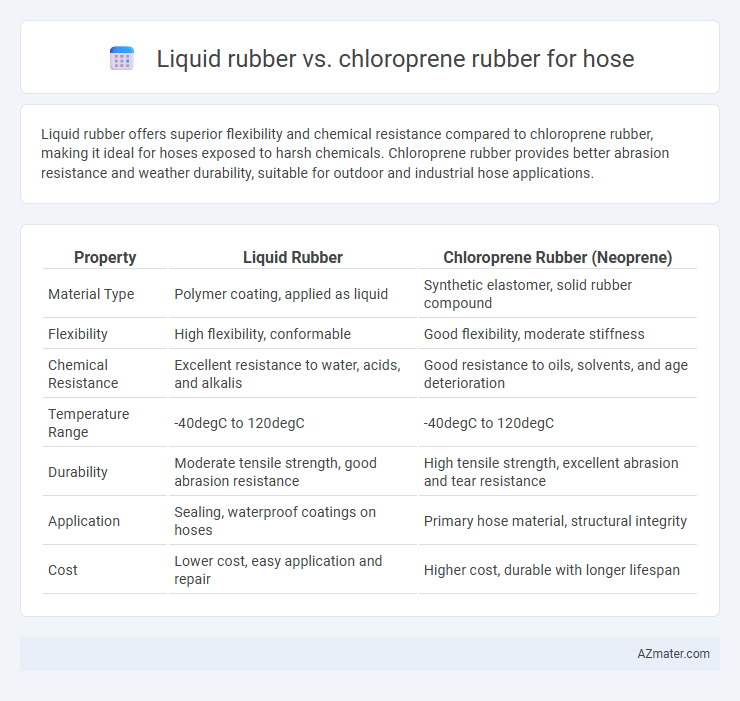Liquid rubber offers superior flexibility and chemical resistance compared to chloroprene rubber, making it ideal for hoses exposed to harsh chemicals. Chloroprene rubber provides better abrasion resistance and weather durability, suitable for outdoor and industrial hose applications.
Table of Comparison
| Property | Liquid Rubber | Chloroprene Rubber (Neoprene) |
|---|---|---|
| Material Type | Polymer coating, applied as liquid | Synthetic elastomer, solid rubber compound |
| Flexibility | High flexibility, conformable | Good flexibility, moderate stiffness |
| Chemical Resistance | Excellent resistance to water, acids, and alkalis | Good resistance to oils, solvents, and age deterioration |
| Temperature Range | -40degC to 120degC | -40degC to 120degC |
| Durability | Moderate tensile strength, good abrasion resistance | High tensile strength, excellent abrasion and tear resistance |
| Application | Sealing, waterproof coatings on hoses | Primary hose material, structural integrity |
| Cost | Lower cost, easy application and repair | Higher cost, durable with longer lifespan |
Introduction to Liquid Rubber and Chloroprene Rubber
Liquid rubber, a versatile elastomeric coating, offers excellent flexibility and waterproofing properties, making it ideal for hose applications requiring superior abrasion resistance and environmental durability. Chloroprene rubber, commonly known as neoprene, provides outstanding resistance to oils, chemicals, and weathering, ensuring reliable performance under harsh industrial conditions. Both materials deliver unique benefits in hose manufacturing, with liquid rubber excelling in seamless protective coatings and chloroprene rubber favored for its chemical stability and mechanical strength.
Composition and Chemical Structure
Liquid rubber is typically composed of styrene-butadiene or nitrile-based polymers with low molecular weight and high fluidity, enabling easy application and curing into flexible, elastic coatings. Chloroprene rubber, also known as polychloroprene, has a chemical structure characterized by chlorinated polyisoprene chains, providing excellent resistance to oils, weathering, and ozone. The presence of chlorine atoms in chloroprene rubber enhances its chemical stability and durability, making it suitable for demanding hose applications where resistance to harsh environments is critical.
Mechanical Properties Comparison
Liquid rubber offers excellent elasticity and superior tensile strength compared to chloroprene rubber, making it highly resistant to cracking and mechanical wear in hose applications. Chloroprene rubber provides balanced mechanical properties, including good abrasion resistance and moderate flexibility, suitable for general-purpose hoses exposed to oils and weathering. The choice between liquid rubber and chloroprene rubber hinges on specific mechanical demands such as flexibility, durability, and resistance to environmental degradation in hose usage.
Resistance to Chemicals and Solvents
Liquid rubber exhibits superior resistance to a wide range of chemicals and solvents, making it ideal for hoses exposed to aggressive substances such as acids, alkalis, and oils. Chloroprene rubber offers moderate chemical resistance, performing well against ozone, weathering, and certain solvents but is less effective against strong acids and alkalis. The choice between liquid rubber and chloroprene rubber for hoses should prioritize the specific chemical exposure and solvent compatibility requirements of the application.
Temperature Tolerance and Thermal Stability
Liquid rubber exhibits superior temperature tolerance, maintaining flexibility and performance in temperatures ranging from -40degC to 150degC, making it ideal for extreme conditions. Chloroprene rubber (Neoprene) offers moderate thermal stability, operating effectively between -40degC and 120degC but can degrade faster under prolonged heat exposure. The enhanced thermal stability of liquid rubber ensures longer hose lifespan in high-temperature applications compared to chloroprene rubber.
Flexibility and Elasticity Factors
Liquid rubber offers superior flexibility and elasticity due to its polymer chain structure, allowing hoses to bend and stretch without cracking under repeated stress. Chloroprene rubber exhibits good elasticity and moderate flexibility, maintaining durability in various temperature ranges but generally lacks the extreme extensibility of liquid rubber. For hose applications requiring extensive flexing and resilience, liquid rubber outperforms chloroprene rubber by providing enhanced elongation and recovery properties.
Durability and Longevity in Hose Applications
Liquid rubber offers exceptional durability for hose applications due to its superior flexibility and excellent resistance to abrasion, weathering, and chemical exposure, ensuring long service life under harsh conditions. Chloroprene rubber, known for its robust mechanical strength and good balance of oil, ozone, and heat resistance, maintains hose integrity in industrial environments but may degrade faster in highly abrasive or chemically aggressive scenarios compared to liquid rubber. The enhanced longevity of hoses coated or lined with liquid rubber makes it a preferred choice for applications requiring sustained performance and reduced maintenance cycles.
Performance in Industrial Environments
Liquid rubber offers superior flexibility and UV resistance, making it ideal for hoses exposed to fluctuating temperatures and outdoor conditions in industrial settings. Chloroprene rubber provides excellent chemical and oil resistance, ensuring durability in harsh environments with exposure to solvents and petroleum products. Both materials exhibit strong abrasion resistance, but chloroprene tends to outperform in maintaining hose integrity under continuous impact and mechanical stress.
Cost Considerations and Availability
Liquid rubber offers a cost-effective solution for hose applications due to its ease of application and minimal processing requirements, often resulting in lower overall production expenses. Chloroprene rubber hoses typically incur higher costs because of their complex manufacturing process and specialized material properties, which ensure durability and chemical resistance. Availability favors chloroprene rubber, as it is widely produced for industrial uses, whereas liquid rubber may have limited supply depending on geographic location and specific formulations.
Conclusion: Choosing the Right Rubber for Hose
Liquid rubber offers superior flexibility, chemical resistance, and ease of application, making it ideal for hoses exposed to harsh environments and frequent movement. Chloroprene rubber excels in durability, weather resistance, and temperature stability, suitable for heavy-duty hose applications requiring robust mechanical strength. Selecting the right rubber depends on specific hose requirements such as flexibility, environmental exposure, and mechanical stress to ensure optimal performance and longevity.

Infographic: Liquid rubber vs Chloroprene rubber for Hose
 azmater.com
azmater.com